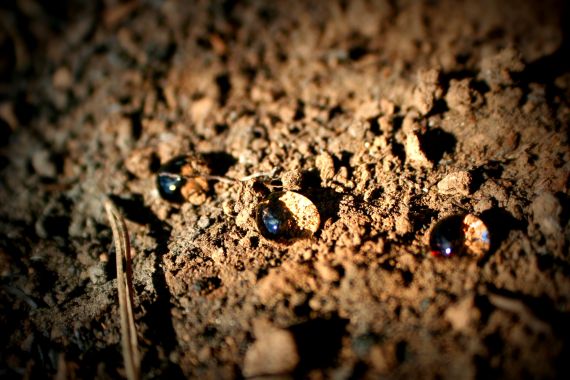This week’s Imaggeo on Mondays is brought to you by the photographer himself, Antonio Jordán (Univerity of Sevilla, Spain), who describes the impact of forest fires on soil properties.

“Soil water repellency” by Antonio Jordán, distributed by the European Geosciences Union under a Creative Commons licence.
This photo was taken while planning some field experiments: in the image, several water drops are resting on a surface soil layer without infiltrating. This process is known as water repellency. Water repellency is a property of soils which, until recently, has not received much attention despite its geomorphological consequences (limiting water infiltration in soils, increasing runoff rates and enhancing the risk of soil erosion). Vegetation, including tree species such as pines or eucalyptus, or shrubs, such as heather, fungi and other soil microorganisms are the main sources of hydrophobic organic substances in soils. Climate, soil texture and structure may also modulate the degree of hydrophobicity.
Forest fires are a major cause of soil water repellency. During the combustion of litter and soil organic matter, some organic substances from the soil volatilise and escape as part of the smoke. However, another part can be displaced in depth and condense following a hot-to-cold gradient. These organic substances form hydrophobic coatings on the surface of soil particles and aggregates. So, when the soil reaches temperatures between 200ºC and 250ºC, water repellency can be increased or induced. If temperature peaks are higher, combustion and volatilization are more intense, and hydrophobic substances may be completely lost or destroyed.
Therefore, soil scientists use soil water repellency as an index of fire severity. A simple way to determine the degree of water repellency is to measure the time required for infiltration of water drops. The development of a water-repellent soil layer, as seen here, together with the loss of vegetation cover that protects soil may trigger soil erosion processes in sensitive areas just to get the first storms of the wet season.
I took this photograph a few days after a forest fire very close to Montellano (Sevilla, SW Spain). The region is characterised by a dense pine forest, shallow soils and steep slopes. The fire affected between 70 and 80ha, quickly climbing the northern slope of the mountain reaching the top, and progressing down the southern slope within a matter of hours.
By Antonio Jordán, University of Sevilla
Imaggeo is the EGU’s online open access geosciences image repository. All geoscientists (and others) can submit their images to this repository and since it is open access, these photos can be used by scientists for their presentations or publications as well as by the press and public for educational purposes and otherwise. If you submit your images to Imaggeo, you retain full rights of use, since they are licensed and distributed by the EGU under a Creative Commons licence.
